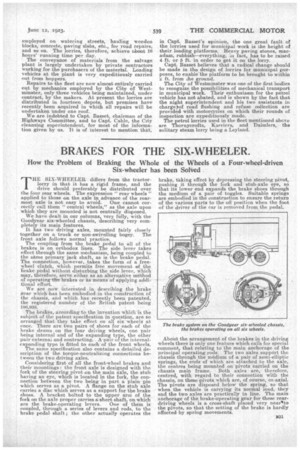BRAKES FOR THE SIX-WHEELER.
Page 15

If you've noticed an error in this article please click here to report it so we can fix it.
How the Problem of Braking the Whole of the Wheels of a Four-wheel-driven Six-wheeler has been SolVed
THE SIX-WHEELER differs from the tractorlorry in that it has a rigid frame, and the drive should preferably be distributed over the four rear wheels. The expression " rear wheels " applied to these on the axle in advance of the rearmost axle is not easy to avoid. One cannot correctly call them "central wheels," as the axle upon which they are mounted is not centrally disposed.
We have dealt in our columns, very fully, with the Goodyear six-wheeled chassis, describing very completely its main features.
It has two driving axles, mounted fairly closely together on a truck or non-swivelling bogey. The front axle follows normal practice.
The coupling from the brake pedal to all of the brakes is on orthodox line's. The side lever takes effect through the same mechanism, being coupled to the same primary jack shaft, as is the brake pedal. The connection, however, takes the form of a freewheel clutch, which permits free movement of the brake pedal without disturbing the side lever, which may, therefore, serve either as an alternative method cif operating the brakes or as means of applying addi tional effort. .
We are now interested in describing the brake gear which has been embodied in the construction Of the chassis, and which has recently been patented, the registered number of the British patent being /86,938. .
The brakes, according to the invention which is the subject of the patent specification in question, are so arranged that they take effect on all six wheels at once. There are two pairs of shoes for each of the brake drums on the four driving wheels, one pair being internal and of the expanding type, the other pair external and contracting. A pair of the internalexpanding type is fitted to each of the front wheels.
The same specification also contains a detailed description of the torque-neutralizing connections between the two driving axles.
Considering first of all the front-wheel brakes and their mountings ! the front axle is designed with the fork of the steering pivot on the main axle, the stub having an eye, which is located in the fork, the connection between the two being in part a plain pin which serves as a pivot. A flange on the stub axle carries a disc which serves as a support for the brake shoes. A bracket bolted to the upper arm of the fork on the axle proper carries a short shaft, on which are the brake-operating levers. One of them is coupled, through a series of levers and rods, to the brake pedal shaft; the other actually operates the
brake, tilling effect by depressing the steering pivot, pushing it through the fork and stub-axle eye, so that its lower end expands the brake shoes through the medium of a pair of toggles. Suitable springs are embodied in the construction to ensure the return of the various parts to the off position when the foot of the driver of the car is removed from the pedal.
About the arrangement of the brakes in the driving wheels there is only one feature which calls for special comment, that relating to the main anchorage of the principal operating rods. The two axles support the chassis through the medium of a pair of semi-elliptic springs the ends of which are attached to the axle, the centres being mounted on pivots carried on the chassis main frame. Both axles are, therefore, centred, with regard to their connection With the chassis, on these pivots which are, of course, co-axial. The pivots are disposed below the spring, so that when the vehicle is carrying its normal load, they and the two axles are practically in line. The main anchorage of the brakessperating gear for these reardriving wheels is a cross-shaft placed very nearIto the pivots, so that the setting of the brake is hardly affected by spring movements.






























